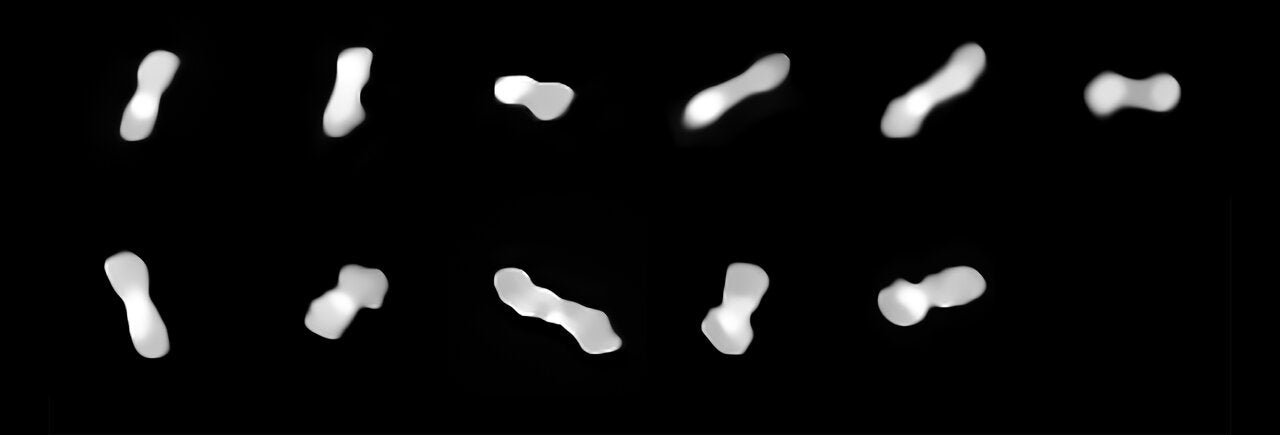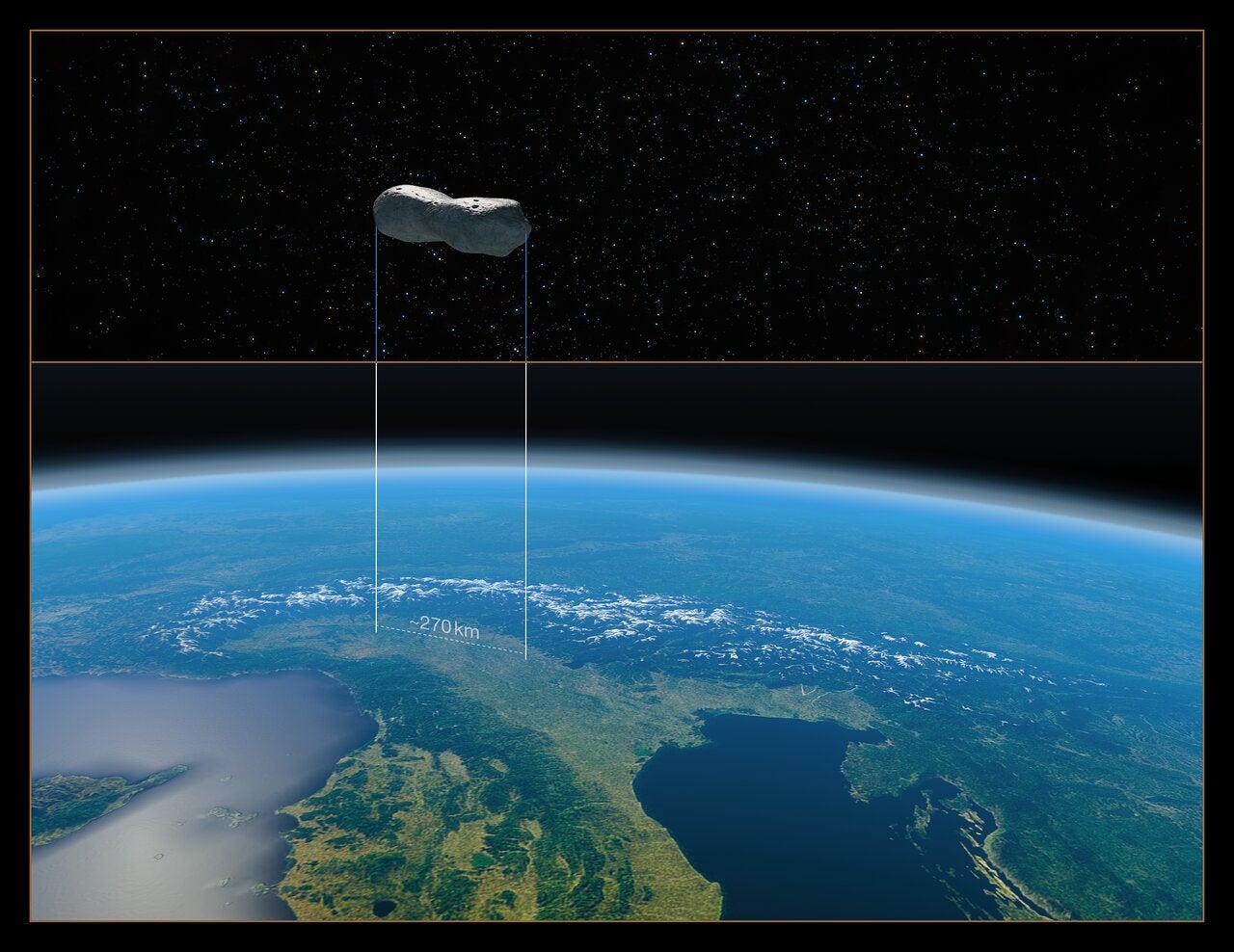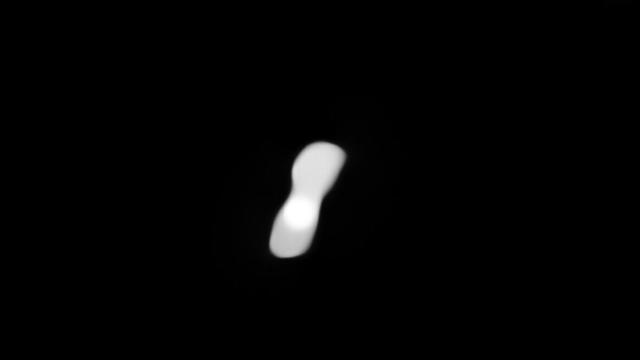Astronomers have captured the best images yet of Kleopatra, a 270 km-long asteroid nicknamed the “dog-bone” on account of its unusual shape. The latest observations are offering fresh insights into the object’s shape and precarious spin and how its moons likely came into existence.
We can now comfortably add asteroid Kleopatra as among the strangest objects in the solar system. In addition to its unusual bone-like shape, it hosts two small moons and has a remarkably low density for a metallic object. What’s more, Kleopatra is spinning so rapidly along its axis that it’s in danger of completely falling apart. In fact, this rapid rate of spin may explain the presence of its two moons, named AlexHelios and CleoSelene.
Such are the findings of two new papers published today in Astronomy & Astrophysics. The first paper is an investigation into the physical properties of the asteroid, such as shape and chemical composition, and was led by Franck Marchis, planetary astronomer at the SETI Institute and chief scientific officer at Unistellar. The second paper analysed the object’s orbital characteristics and its two moons, and it was led by Miroslav Brož, an astronomer from Charles University in the Czech Republic.

Marchis credited the European Southern Observatory’s Very Large Telescope for making these discoveries possible. Indeed, Kleopatra may be relatively big — 270 km along its axis — but it’s far away, in the main asteroid belt between Mars and Jupiter, making it very faint. The asteroid never gets closer to Earth than around 200 million km.
To see details of Kleopatra’s shape and detect its moons, “we need to overcome the blurring effect of the Earth atmosphere,” explained Marchis in an email. “This is doable thanks to adaptive optics on a large telescope like the VLT.” To reach the desired level of quality, the team used the Spectro-Polarimetric High-contrast Exoplanet REsearch (SPHERE) instrument attached to the VLT.
“The SPHERE instrument is one of these next-generation adaptive optics systems which is now capable of working in visible light,” said Marchis. “Consequently, it provides images in optical light — in this case in red — with the full resolution of the 8m-telescope, like if the VLT were in space.” To which he added: “Thanks to this amazing image quality, we can now see details about the shape of the asteroid, see the two lobes and the bridge connecting them.”
Astronomers have known about this object for a long time. Czech astronomer Johann Palisa discovered Kleopatra in 1880, and it seems to get weirder with each subsequent observation. Astronomers discovered the first of its two moons in 1980, the result of a fortuitous eclipse. Radar observations in 2000 hinted at a very unusual shape, earning it the nickname “dog-bone asteroid,” as the object appears to have two lobes connected by a relatively narrow “neck.” In 2011, a team led by Marchis announced the discovery of the second moon, which they found with the Keck II optical telescope. The moons were formally recognised and named for Cleopatra’s children.

Despite these observations, many questions remained. The orbits of AlexHelios and CleoSelene had to be “approximated, since we had a few data points,” and the shape of Kleopatra likewise had to be approximated, “so we could not say with certainty the density of the asteroid or the origin of the moons,” Marchis explained. “We already knew that this triple asteroid system was unique because of the shape of [Kleopatra].” Other outstanding questions had to do with the object’s size, orbit, and rotation. Accordingly, the new studies are greatly expanding our understanding of this unique triple system.
The team observed Kleopatra and its moons in 2017 and 2019 from different angles, resulting in a three-dimensional view of the asteroid. The team got a better sense of its size and learned that one of its lobes is larger than the other.
In addition, they finally determined the precise orbits of the moons. As it turns out, the previous estimates were quite wrong, resulting in erroneous inferences. Miroslav Brož, an astronomer from Charles University in the Czech Republic and the first author of the second paper, said the updated orbital calculations are important because this allowed them to compute the asteroid’s true mass and radius (or at least, an improved estimate of these parameters).

Another key finding suggests the asteroid is spinning near its critical speed; any faster and it risks breaking apart. The object rotates once every five hours.
“Actually, we know it more precisely, at 5.3852827 hours,” Brož said in an email. “This might seem normal for an asteroid, but Kleopatra is so long, that at its ends, the rotation speed is very close to the escape speed.” Brož is referring to the required speed for an object to escape its gravitational bounds. He suspects that, should Kleopatra be hit by another asteroid, it could result in an even faster spin, causing it to break apart on its own.
With the correct orbits determined, the team came up with a figure for Kleopatra’s mass that is 35% lower than previous estimates. Kleopatra is a metallic object, but it appears to be less than half the density of iron. This suggests the asteroid is a porous “rubble pile” that formed from a big impact. Kleopatra is a relatively loose conglomeration of small objects, but given its high rate of spin, it might actually be spewing some debris into space. And in fact, this might explain how AlexHelios and CleoSelene came into existence.

“Due to the shape and spin of the main asteroid, we have calculated that some areas of Kleopatra are … unstable, meaning that a boulder located there would be ejected,” Marchis explained. “We can’t yet prove it, but it’s possible that the moons are indeed infants of the main asteroid, ejected after an oblique impact and formed by accreting those ejected pebbles and boulders.”
Astronomers know of other extremely elongated asteroids, such as the Trojan asteroid 624 Hektor and the main belt asteroid 121 Hermione. Marchis said it’s probably not a coincidence that both of those asteroids have their own moons.
The team also learned new things about the two moons. AlexHelios is the farther of the two, at 655 km away from Kleopatra, while CleoSelene is 499 km away (as measured from the centre of Kleopatra). The moons are slightly smaller than 10 km in size and possibly spherical, but the scientists don’t actually know.
“Hopefully, they will be observed in the future, during an occultation event, when Kleopatra and moons pass in front of a star, so that observers on Earth can measure their shadows,” said Brož.
Looking ahead, the team would like to re-measure the moons’ orbits, which they plan to do next year. They expect to find some anomalies in their motion, due to tidal effects and unexpected perturbations due to Kleopatra’s unusual shape. Finding a third moon is not outside the realm of possibility, said Marchis.
Indeed, astronomers have been observing this dog-bone asteroid for over 140 years, and there’s no reason to believe it won’t keep getting weirder.
